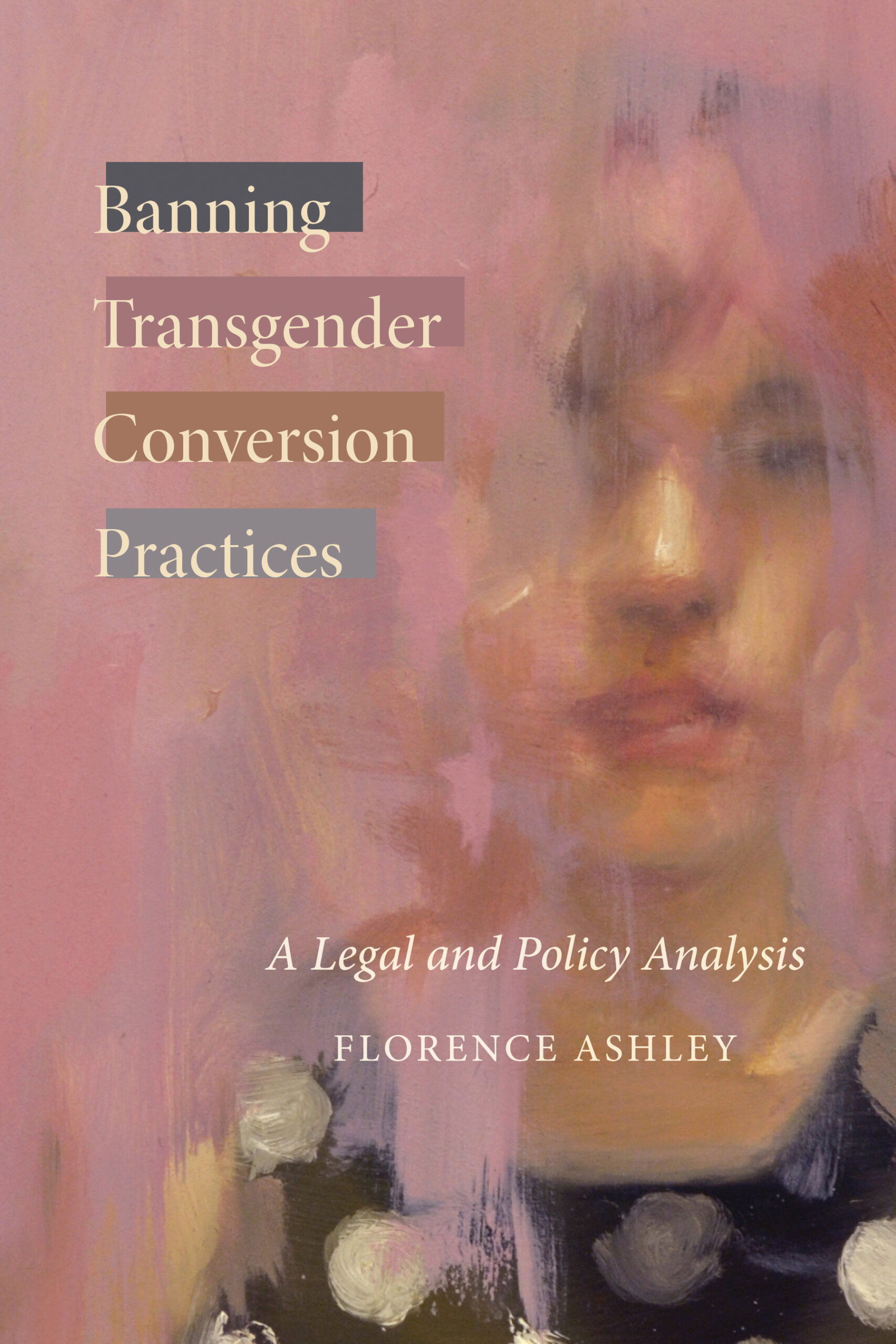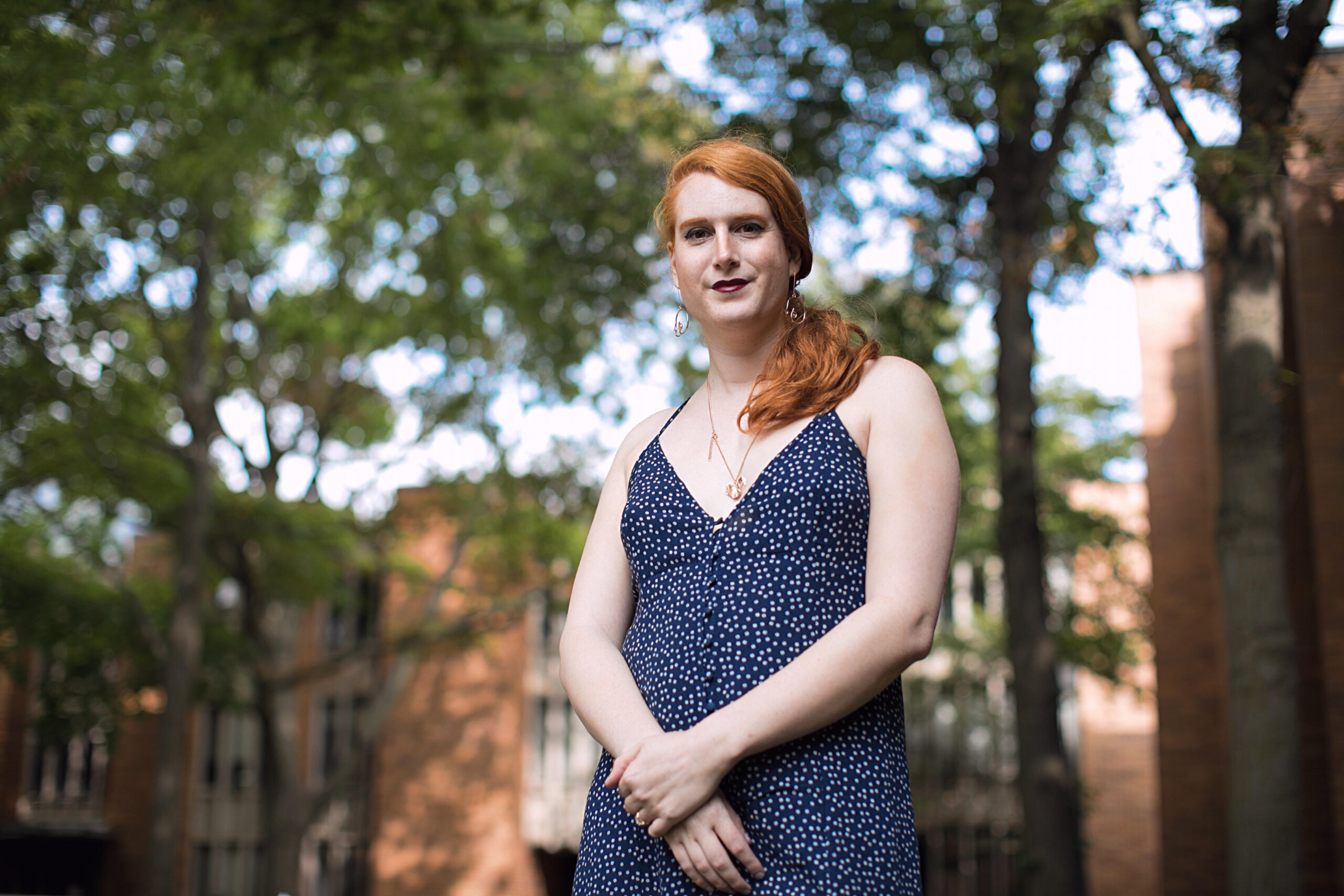Florence Ashley describes themselves as a transfeminine jurist, bioethicist, public speaker and activist. They were the first openly transfeminine person to clerk at the Supreme Court of Canada, which they did under Justice Sheilah Martin. Their new book, Banning Transgender Conversion Practices: A Legal and Policy Analysis, published this month by UBC Press, emerged out of their work as a master’s student in law and bioethics at Montreal’s McGill University and then as a doctoral student at the University of Toronto Faculty of Law and the Joint Centre for Bioethics.

Credit: Courtesy UBC Press
The book, Ashley’s first, steps directly into the middle of debates not only around conversion practices, which have been banned in Canada and several other jurisdictions around the world, but about the role that health care practitioners have in the lives of trans people—particularly those who want physical transition through medical interventions like hormones and surgery. In fact, Ashley participated in the consultations that led to the wording of Canada’s national ban on conversion therapy.
Xtra interviewed Ashley via Zoom from their home in Toronto about what they hope to achieve—and what they learned—by writing the book.
Let’s start at the beginning. What was your motivation for writing the book? Where did the idea come from?
The book took root in my master’s research. I had initially wanted to do research on gatekeeping in trans health care, but then I really started seeing that things were moving on conversion practices and that the experiences of trans people were not being adequately represented in the discussions surrounding conversion practices and bans of conversion practices. I have not personally experienced conversion practices, but I know so many people—close friends, people I’ve dated, people in the community—that have been so deeply negatively impacted by conversion practices. It’s really hard to get a group of trans people together and not have at least one person who’s experienced conversion practices. It just felt so important to bring a different kind of lens than a lot of the other literature because I really believe in survivor-led work. I really see my job as a scholar is that of a translator, but instead of translating between languages, I’m translating between spheres of knowledge.
Canada has just imposed a national ban on conversion practices. In the book, you propose a model law that jurisdictions could use to ban the practice. How does Canada’s law hold up against your ideal?
It doesn’t hold up very well. I was involved in drafting the bill, so it was a weird experience when I was revising the book because as drafts of the book started to have an impact on policy and law, I almost had to be self-referential. But I don’t think the Canadian ban got things right, and I say that as someone who has written part of the wording in that law. Some of the law is a just copy-paste of things I’ve written and somehow they still managed to fuck it up.
What did they mess up?
They have this language: “For greater certainty, this definition does not include a practice, treatment or service that relates to the exploration or development of an integrated personal identity—such as a practice, treatment or service that relates to a person’s gender transition—and that is not based on an assumption that a particular sexual orientation, gender identity or gender expression is to be preferred over another.” This language, without the parentheses, was what was proposed by a coalition of survivors and experts to say that it’s fine to do exploration, to integrated personal identities [for example, to get counselling about how to reconcile a religious belief with one’s gender identity or sexual orientation], so long as there’s no kind of preference for any particular outcome. But the part about a person’s gender transition—it was originally meant to just make sure that everybody understands that things like hormones, like surgery, are not conversion practices. To fit it in this paragraph about exploration or development of an integrated personal identity—that’s something completely different. One is about psychotherapy. One is mostly physical, medical interventions. They stuck it right in the middle so that it makes almost no sense.
What could be the bad effect of that?
It will primarily just confuse people, but I think that the general gist of what they intended will probably be picked up by judges. Confusion is going to lead to litigation, taking longer and racking up more costs. I’m more concerned about how it’s going to just create unnecessary bumps in the road during the process.
A lot of the public debate about conversion practices and banning it has been about LGBTQ2S+ people more generally or focused mostly on sexual orientation. But you focus specifically on transgender conversion. Can you explain how these practices are different for trans people than for gay, lesbian and bisexual people? Are they rarer or more commonplace?
It’s actually much more widespread for trans people. There are many layers to that. When early clinics started doing conversion “therapy,” the idea was to discourage effeminacy in children assigned male at birth with the goal of preventing them from becoming gay or, even worse, trans. Their logic was that you had a pathway from being a gender-nonconforming kid to being gay to potentially being trans. Trans was seen as worse, a more intense version of being gay. As there was opposition to this thinking raised in the clinical community, and there was progress, people wondered if it was possible to change orientation and also whether it was desirable, so you had practitioners dropping the motivation to change sexual orientation. But they held onto the idea that they needed to prevent people from growing up trans. Maybe being gay is okay, but being trans is certainly not okay.
To make things even worse, gay, lesbian and bisexual people may not have a lot of contact with the medical system, the mental health system, compared to trans people because when you’re trans you’re often seeking medical transition. You end up seeing somebody who gives you that checkmark to say, “Yes, you can transition.” Those interactions create a huge potential for conversion practices. A practitioner can say, “You can only transition after you go through this therapy with me, which is conversion therapy, and only if you come out the other end with me believing you’re trans and you still believing it, then I’ll let you transition.” So basically, the condition of receiving gender-affirming care is going through conversion therapy. Fewer and fewer licensed professionals do gay conversion therapy—it’s been increasingly shifted to solely religious settings. But that’s not quite true with trans people. In fact, we’re experiencing what seems to be a resurgence of conversion practices targeting trans people because of the backlash against trans rights movements. So it’s been quite worrisome.
The Gender Identity Clinic at Toronto’s Centre for Addiction and Mental Health (CAMH) plays a large role in your book—it’s how you introduce us to trans conversion practices. The youth clinic was shut down in 2015 and other programs have been reinvented, but for years it was influential across Canada and in other countries. Did you focus on it primarily because of that influence?
Absolutely. Also, CAMH and the Ontario experience is virtually the only instance in which the experiences of trans people were central to a law banning conversion practices. [The province of Ontario banned conversion practices in 2015, the same year the clinic was closed.] Everywhere else, trans people have sort of been an afterthought to bans on conversion practices. But in Ontario, it was very much central to the passing of Bill 77. It was a story that really spoke to just how pervasive conversion practices were in Canada. Now, I know that a lot of people associated with CAMH denied they were doing conversion practices, but based on how I understand conversion practices, they were doing [them], which, in their own words, was the goal of preventing kids from growing up trans, that transitioning was sort of a last resort for kids who couldn’t be convinced to be cisgender. So many trans people in Ontario and in Canada went through that clinic, which was hugely influential in shaping practices around the world. It could be argued that they were a leading exporter of conversion practices.
Your book works to provide a legal and ethical framework around trans conversion therapy and how to ban it. One of your key arguments is that people can’t consent to it.
There are two things: whether there can be valid consent to it and whether we should care if there’s valid consent. We have good reasons to doubt whether you can have valid consent because a lot of people are motivated to consent to conversion practices because of family or community pressure or manipulation. Fear of being ostracized or facing violence, but also a lot of internalized homophobia and transphobia, which can be directly manipulated by practitioners or can be tacitly relied upon to obtain what looks like consent. There’s also the fact that so many trans people just consent because they see it as the only option to get gender-affirming care. Without this motivation rooted in transphobia and homophobia, why would anyone be interested in conversion practices, right?
Should we care about consent even if it were possible? In health care, we generally think that, for instance, you can’t consent to things that will be harmful to you. You can’t just take an experimental drug because you want it; there’s still a process before you’re allowed. Then you have the prohibition of sexual relationships between health care professionals and patients because it’s understood that even if it doesn’t necessarily harm every single one of them, it’s such a grave risk that we don’t let health care professionals do it, regardless of whether valid consent could be obtained. Similarly, in criminal law, we don’t let people consent to grave harm; you can’t consent to someone murdering you or severing your arm unless it’s within a medical context.
The book, like the laws we’ve seen, focuses on institutions and professionals. But I’m curious about a situation where, say, parents develop their own system to try to convert their trangender child. Does any of this apply to them?
They definitely could if their practices are sufficiently systematic. However, the primary emphasis is on institutions and professionals for the simple reason that they’re the ones most subject to regulation so they’re the ones that are easiest to discourage. Parents operate within a much more private sphere that is difficult to deal with. But it could apply to them if you had laws for when survivors decide they want to launch a complaint or lawsuit.
I want to ask two questions about the future. Firstly about what should happen next in places that have bans on conversion practices, like Canada, Malta, France, parts of Spain and U.S. states like Colorado, Maine and Utah. In these places, is the issue done and done?
These laws are the first step. They’re the farthest thing from us being done. It’s the start of the conversation. Canada’s federal law is a criminal law, which is extremely disempowering to survivors and makes it difficult to apply, difficult to secure a conviction. It’s not necessarily desirable to send people to jail. To criminalize is a blunt instrument. We need to have a means of effective redress for survivors. And right now, the court system isn’t accessible, the law is difficult to navigate and we also need shifts in culture because law is just not enough. So we need professional associations to actually step up and start these discussions to help their members identify conversion practices, understand how to prevent them, to communicate to their members what conversion practices are, in very detailed ways, because right now we have very abstract definitions that just aren’t that precise. Then we need financial support for survivors because people who have experienced conversion practices have already experienced them, no matter how many laws we put in place. So we need mental health support for survivors that is actually geared towards them. Unfortunately, there’s very little funding directed towards that.
Secondly and finally, I wanted to ask about places that don’t have conversion therapy bans, which is most of the world. In fact, in the United States in particular, there’s a lot of anti-trans legislation happening now. What do you see as the role of your book in these debates?
When I was starting the book, I had this fear that it would not be relevant by the time it came out, and it would just be this mostly useless book because everybody would be on track to agree that conversion practices were bad. Then there’s that very sad realization that this is the opposite of what’s happening. I’m glad that the book is going to be there for that political moment, but I’m very sad we’re in a political moment that makes the book relevant. I don’t think legislators in Texas are going to pick up my book and be like, “Yeah, we’re going to adopt this model law.” But it might influence legislatures held by the Democrats. And it might impact places outside of the U.S., because the U.S. isn’t the centre of the world, as much as it likes to think so.
This interview has been edited for length and clarity.


 Why you can trust Xtra
Why you can trust Xtra


